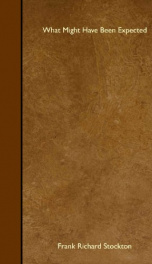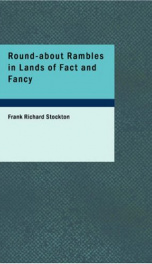Stockton Frank Richard

Frank Richard Stockton (April 5, 1834 – April 20, 1902) was an American writer and humorist, best known today for a series of innovative children's fairy tales that were widely popular during the last decades of the 19th century. Stockton avoided the didactic moralizing, common to children's stories of the time, instead using clever humor to poke at greed, violence, abuse of power and other human foibles, describing his fantastic characters' adventures in a charming, matter-of-fact way in stories like "The Griffin and the Minor Canon" (1885) and "The Bee-Man of Orn" (1887), which was published in 1964 in an edition illustrated by Maurice Sendak. His most famous fable is "The Lady, or the Tiger?" (1882), about a man sentenced to an unusual punishment for having a romance with a king's beloved daughter. Taken to the public arena, he is faced with two doors, behind one of which is a hungry tiger that will devour him. Behind the other is a beautiful lady-in-waiting, whom he will have to marry, if he finds her. While the crowd waits anxiously for his decision, he sees the princess among the spectators, who points him to the door on the right. The lover starts to open the door and ... the story ends abruptly there. Did the princess save her love by pointing to the door leading to the lady-in-waiting, or did she prefer to see her lover die rather than see him marry someone else? That discussion hook has made the story a staple in English classes in American schools, especially since Stockton was careful never to hint at what he thought the ending would be (according to Hiram Collins Haydn in The Thesaurus of Book Digests, ISBN 0-517-00122-5). Born in Philadelphia, Stockton was the son of a prominent Methodist minister who discouraged him from a writing career. For years of his life he lived off a dime a day to help support his family. That money was enough to buy his family a loaf of bread and meat for dinner. In 1867, he moved back to Philadelphia to write for a newspaper founded by his brother. His first fairy tale, "Ting-a-ling," was published that year in The Riverside Magazine; his first book collection appeared in 1870. In 1868, Stockton joined the staff of the new magazine Hearth and Home, working as an assistant editor under Mary Mapes Dodge, author of Hans Brinker, or the Silver Skates. He contributed not only fairy tales, but also stories and articles on a variety of subjects for adults. In 1874, Stockton was made assistant editor of Saint Nicholas Magazine, a new magazine for children, again under Mary Mapes Dodge. He worked there until 1878, when he was forced to resign the position due to failing eyesight. He continued to write, however, dictating to his wife or a professional secretary, and produced a large body of popular work for children and adults through the end of the century. He died of a cerebral hemorrhage in 1902, and was buried in The Woodlands Cemetery. His collected works, 23 volumes of stories for adults and children, were published between 1899 and 1904. Francis Richard Stockton was one of the most popular American humorists of the late nineteenth century, excelling in stories of whimsical fancy, in episodic novels of domestic comedy, and in tales of the occult and supernatural. A descendant of one of the signers of the Declaration of Independence, Stockton was the third son of William Smith Stockton and his second wife, Emily Drean Stockton. Because his physique was generally frail and because he had been born with one leg shorter than the other, young Frank was severely limited in his childhood activities. On his daily walks to school, however, he began to develop his imaginative faculties by orchestrating dramas in his mind, plotting serial tales for his personal diversion. He told those stories to his siblings each day starting where he left off. He later noted, “I caused the fanciful creatures who inhabited the world of fairy-land to act . . . as if they were inhabitants of the real world.” Such creative strategy later came to characterize Stockton’s most successful children’s literature and science fiction. At Central High School in Philadelphia, Stockton won a short-story contest, an achievement which encouraged his aspirations toward an eventual career in writing. In 1852, though, when he graduated, Stockton was apprenticed to a wood engraver and for the next fourteen years worked for a living at this craft, accumulating rejection slips for his occasional forays into fiction. By 1859, he had published only two short stories. In 1860, Stockton married Mary Anne (or Marianne) Edwards Tuttle (her first name has also been spelled without the e). He then began to apply himself more vigorously to his writing, and he soon had a serialized tale accepted for publication in the prestigious Southern Literary Messenger, a journal at one time partially written and edited by Edgar Allan Poe (1809-1849). A brief, uncharacteristic political posture manifested itself at this time in Stockton’s life: He published a pamphlet supporting the right of the South to secede from the Union. When Fort Sumter fell, however, Stockton, a genial, amiable gentleman who actually abhorred controversy, withdrew the slender publication and, for the rest of his life, happily avoided any social or political dispute. When Stockton published “Ting-a-Ling,” a fairy tale about a giant and a dwarf, in Riverside Magazine in 1867, he came to the attention of Mary Mapes Dodge (1831-1905), soon to be recognized as a significant force in children’s literature. Dodge hired Stockton as her assistant editor on Hearth and Home, a periodical for the juvenile market. He was now able to focus his complete attention on the literary arena, and when five years later Dodge assumed the editorship of the classic St. Nicholas magazine, she took Stockton along to continue as her assistant editor. Stockton not only helped edit St. Nicholas but also contributed tales under his own name and under the pseudonyms Paul Fort and John Lewes. In 1876, Stockton began experiencing eye difficulties, problems exacerbated by his increasingly heavy load of editorial work and his demanding writing schedule; by 1878, he was forced to resign his post at St. Nicholas. From then on, with his wife often acting as his amanuensis and reader, Stockton devoted himself to his own creative writing, with humor constituting his major orientation. He observed, “The discovery that humorous compositions could be used in journals other than those termed comic marked a new era in my life.” Sitting comfortably in his New Jersey home, Stockton dictated stories and novels which, he insisted, were without hidden philosophic meaning or deep, critical implications. Success as an entertainer was his simple aim. His best-known works now began to appear in book form as well as in such popular magazines of the day as Cosmopolitan, Scribner’s, and the Ladies’ Home Journal. A resounding success was the episodic novel Rudder Grange, vignettes chronicling the misadventures of a newly married couple who, with their shrewd but often miscalculating maid Pomona, settle on a houseboat. The audience demanded sequels, and Stockton delivered more sketches of the hapless group in The Rudder Grangers Abroad, and Other Stories and Pomona’s Travels. Stockton’s most memorable piece, however, the one for which succeeding generations of readers have remembered and will continue to remember his name is “The Lady, or the Tiger?” a tale originally appearing in Century’s Magazine for November, 1882. The story’s challenging conclusion spawned much speculation as intrigued readers endeavored to disentangle the verbal clues in pursuit of a solution to this literary cipher that is timelessly intriguing. He also wrote a sequel to the story, "The Discourager of Hesitancy". From time to time, Stockton exploited occultist worlds and other spiritualist manifestations in his imaginative prose. “The Lady in the Box,” for example, a tale from John Gayther’s Garden and Stories Told Therein, is strongly reminiscent of Poe and the elements of gothic mystery as a woman’s cataleptic trance is controlled in history, a phenomenon enabling her to transcend forty years without aging. The Great Stone of Sardis, set in the New York of 1947, deals with materials virtually foreign to the pre-twentieth century sensibility: submarines, sophisticated communications systems, and the existence of a mammoth diamond located in the very center of the earth. The influence of Jules Verne (1828-1905) on Stockton’s science-fiction work is most clearly noticeable in this story. 'The Great War Syndicate' proposes a small war between the USA and UK over fishing rights off the Canadian coast and is interesting not only because of the innovative weaponry used by the USA but more by the fact that the US Government out-sources the war to a private 'Syndicate' (group of Capitalists) who are then paid on a sliding scale, by the spped at which they successfully conclude the war. End it faster, get paid more! The Stocktons retired to an estate they had purchased in West Virginia. In mid-April, 1902, Stockton attended the banquet of the National Academy of Sciences in Washington, D.C. While there, he was taken ill and carried to his hotel room, where he died of a cerebral hemorrhage. Stockton was buried in Woodland Cemetery, Philadelphia, not far from the spot where he had been born.
do you like this author?
What readers are saying
What do you think? Write your own comment on this book!
write a commentWhat readers are saying
What do you think? Write your own comment on this author!
write a commentBook list

The DusantesA Sequel to "The Casting Away of Mrs. Lecks and Mrs. Aleshine"
Series:
Unknown
Year:
Unknown
Raiting:
3/5
Show more
add to favoritesadd In favorites
Book list

The DusantesA Sequel to "The Casting Away of Mrs. Lecks and Mrs. Aleshine"
Series:
Unknown
Year:
Unknown
Raiting:
3/5
Show more
add to favoritesadd In favorites

Amos Kilbright; His Adscititious Experiences
With Other Stories
Series:
Unknown
Year:
Unknown
Raiting:
4.5/5
Show more
add to favoritesadd In favorites

Pomona's Travels
A Series of Letters to the Mistress of Rudder Grange from her Former Handmaiden
Series:
Unknown
Year:
Unknown
Raiting:
4/5
Show more
add to favoritesadd In favorites

The Associate Hermits
Series:
Unknown
Year:
Unknown
Raiting:
4/5
This volume is produced from digital images created through the University of Michigan University Library's large-scale digitization efforts. The Library seeks to preserve the intellectual content of items in a manner that facilitates and promotes a variety of uses. The digital reformatting process results in an electronic version of the original text that can be both accessed online and used to create new print copies. The Library also understands and values the usefulness of print and makes reprints available to the public whenever possible. This book and hundreds of thousands of others can be found in the HathiTrust, an archive of the digitized collections of many great research libraries. For access to the University of Michigan Library's digital collections, please see http://www.lib.umich.edu and for information about the HathiTrust, please visit http://www.hathitrust.org
Show more
add to favoritesadd In favorites

What Might Have Been Expected
Series:
Unknown
Year:
Unknown
Raiting:
3/5
Two children rescue an elderly woman from going to the alms-house by raising enough money to enable her to live in her own log cabin. --This text refers to the Hardcover edition.
Show more
add to favoritesadd In favorites

The Vizier of the Two-Horned Alexander
Series:
Unknown
Year:
Unknown
Raiting:
1/5
This book was converted from its physical edition to the digital format by a community of volunteers. You may find it for free on the web. Purchase of the Kindle edition includes wireless delivery.
Show more
add to favoritesadd In favorites

Ting-a-ling
Series:
Unknown
Year:
Unknown
Raiting:
2.5/5
Illustrated by E. B. Bensell --This text refers to the Paperback edition.
Show more
add to favoritesadd In favorites

The Stories of the Three Burglars
Series:
Unknown
Year:
Unknown
Raiting:
3.5/5
But I had business to attend to before I could go upstairs. In thinking over and arranging this plan for the capture of burglars, I had carefully considered its various processes, and had provided against all the contingencies I could think of; therefore I was not now obliged to deliberate what I should do. "Keep your eye on them," said I to David, "and if one of them moves be ready for him. The first thing to do is to tie them hand and foot." --This text refers to an alternate Paperback edition.
Show more
add to favoritesadd In favorites

Stories of New Jersey
Series:
Unknown
Year:
Unknown
Raiting:
1/5
This volume is produced from digital images created through the University of Michigan University Library's large-scale digitization efforts. The Library seeks to preserve the intellectual content of items in a manner that facilitates and promotes a variety of uses. The digital reformatting process results in an electronic version of the original text that can be both accessed online and used to create new print copies. The Library also understands and values the usefulness of print and makes reprints available to the public whenever possible. This book and hundreds of thousands of others can be found in the HathiTrust, an archive of the digitized collections of many great research libraries. For access to the University of Michigan Library's digital collections, please see http://www.lib.umich.edu and for information about the HathiTrust, please visit http://www.hathitrust.org
Show more
add to favoritesadd In favorites

The Squirrel Inn
Series:
Unknown
Year:
Unknown
Raiting:
5/5
Originally published in 1891. This volume from the Cornell University Library's print collections was scanned on an APT BookScan and converted to JPG 2000 format by Kirtas Technologies. All titles scanned cover to cover and pages may include marks notations and other marginalia present in the original volume.
Show more
add to favoritesadd In favorites

The Rudder Grangers Abroad and Other Stories
Series:
Unknown
Year:
Unknown
Raiting:
3/5
The sun shone warm and soft as it shines in winter time in the semi-tropics. The wind blew strong as it blows whenever and wherever it listeth. Seven pelicans labored slowly through the air.
Show more
add to favoritesadd In favorites

Rudder Grange
Series:
Unknown
Year:
Unknown
Raiting:
2/5
A humorous novel and the best known work of a country life in Middle America in the late 1800s by Thonias Hewlings Stockton, a nineteenth century American writer and humorist, best known today for a series of innovative children's fairy tales. The author wrote under a pen name of Frank Richard Stockton. Published in 1879, it was followed by "The Rudder Grangers Abroad” in 1891 and “Pomona's Travels” in 1894.
Show more
add to favoritesadd In favorites

Round-about Rambles in Lands of Fact and Fancy
Series:
Unknown
Year:
Unknown
Raiting:
3.5/5
Frank R. Stockton (1834-1902) was an American writer and humorist, best known today for a series of innovative children's fairy tales that were widely popular during the last decades of the 12th century. Stockton avoided the didactic moralizing common to children's stories of the time, instead using clever humor to poke at greed, violence, abuse of power and other human foibles, describing his fantastic characters' adventures in a charming, matterof- fact way in stories like The Griffin and the Minor Canon (1885) and The Bee-Man of Orn and Other Fanciful Tales (1887). His most famous fable is The Lady, or the Tiger? (1882), which is about a man sentenced to an unusual punishment for having a romance with a king's beloved daughter. --This text refers to an alternate Paperback edition.
Show more
add to favoritesadd In favorites
What readers are saying
What do you think? Write your own comment on this author!
write a commentGenre
- Literature & Fiction / Contemporary
- Literature & Fiction / Classics
- Literature & Fiction / General AAS
- Health, Mind & Body / General
- Literature & Fiction / Genre Fiction / Action & Adventure
- Nonfiction / Education / Education Theory / History
- Science / Earth Sciences / Geography
- Literature & Fiction / Short Stories
- Science / Earth Sciences / Geology
if you like Stockton Frank Richard try:
readers also enjoyed
What readers are saying
What do you think? Write your own comment on this author!
write a commentGenre
- Literature & Fiction / Contemporary
- Literature & Fiction / Classics
- Literature & Fiction / General AAS
- Health, Mind & Body / General
- Literature & Fiction / Genre Fiction / Action & Adventure
- Nonfiction / Education / Education Theory / History
- Science / Earth Sciences / Geography
- Literature & Fiction / Short Stories
- Science / Earth Sciences / Geology
if you like Stockton Frank Richard try:
readers also enjoyed
Do you want to exchange books? It’s EASY!
Get registered and find other users who want to give their favourite books to good hands!


